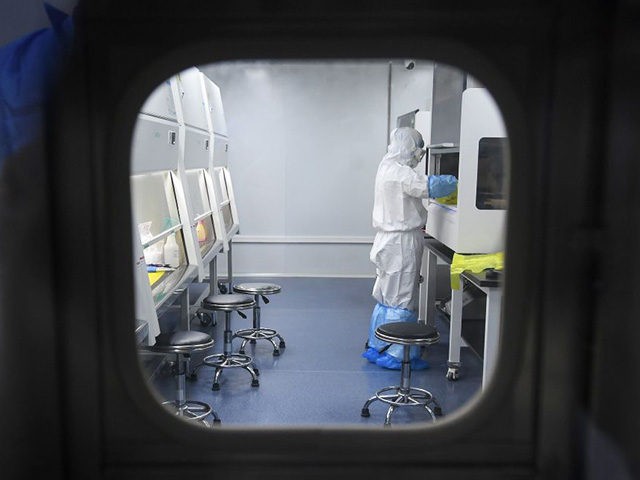Canada’s CBC News reported Sunday on the discovery of documents that show deadly pathogens, including Ebola virus samples, were shipped from Canada’s National Microbiology Lab to China’s now-infamous Wuhan Institute of Virology last year.
The Royal Canadian Mounted Police (RCMP) are investigating several of the people involved in the transfer, although Canadian health officials said those investigations are not directly related to the shipment of pathogens.
CBC first reported on the March 2019 shipment of pathogens in August, long before the coronavirus pandemic put the Wuhan Institute of Virology on the global map. Even back then, the shipment of Ebola and other Level 4 pathogens was regarded as unusual and potentially dangerous, since the safety procedures of the Canadian national laboratory might have been circumvented during the shipment, and some of the paperwork necessary to protect the intellectual property rights of the Canadian researchers had not been completed.
The Public Health Agency of Canada (PHAC) insisted the transfer of viruses was a routine response to a scientific request from Chinese researchers and all of the appropriate safety precautions were taken. PHAC was less clear about if the intellectual property paperwork had been filled out correctly.
Two months after the Level 4 virus shipment was made, PHAC asked the RCMP to investigate an “administrative matter” that led to the removal of two married Chinese research scientists named Xiangguo Qiu and Keding Cheng, along with several international students, from the Canadian National Microbiology Lab. Qiu was head of the vaccine development program in the lab’s Special Pathogens Program, while her husband Cheng was a biologist who worked for PHAC.
Qiu and Cheng were not politely asked to leave the laboratory; their security clearances were terminated and they were escorted from the premises. Soon afterward, the University of Manitoba ended its relationship with both Chinese scientists and reassigned all the graduate students Qiu had been teaching.
“If China was leveraging these scientists in Canada to gain access to a potentially valuable pathogen or to elements of a virus without having to license the patent … it makes sense with the idea of China trying to gain access to valuable IP without paying for it,” national security legal expert Leah West explained in August.
Documents described by CBC News on Sunday confirmed that Qiu was directly involved with the transfer of Level 4 pathogens to the Wuhan laboratory, a connection that was previously unclear.
The documents also provided the first itemized list of the pathogens sent from Canada to China, including three different strains of Ebola and two strains of the extremely dangerous Henipah virus.
The paperwork revealed a troubling amount of “confusion over how to package the deadly viruses,” concerns about failure to decontaminate the package, and concerns from Canadian National Microbiology Lab Director-General Matthew Gilmour about the uncertain ultimate destination of the package. Gilmour appeared to be troubled that a great deal was being taken on faith from Dr. Qiu based on her sterling reputation and, two months later, she was escorted from the Canadian lab by security and dismissed from the university where she taught, for reasons that are still being kept largely confidential.
As for how the pathogens were handled, the newly revealed documents included the stunning detail that the Canadian lab was about to ship the Level 4 viruses in “inappropriate packaging,” but hastily corrected their shipping procedures when the Chinese recipients noticed the error.
PHAC officials still maintain the RCMP investigation that led to her dismissal had nothing to do with the pathogen transfer or the subsequent outbreak of the Wuhan coronavirus. Epidemiologist and law professor Amir Attaran of the University of Ottawa nevertheless told CBC the news of Qiu’s involvement with the pathogens is “suspicious,” “alarming,” and “potentially life-threatening.”
“We have a researcher who was removed by the RCMP from the highest security laboratory that Canada has, for reasons that the government is unwilling to disclose,” Attaran noted.
“The intelligence remains secret. But what we know is that before she was removed, she sent one of the deadliest viruses on Earth, and multiple varieties of it to maximize the genetic diversity and maximize what experimenters in China could do with it, to a laboratory in China that does dangerous gain of function experiments, and that has links to the Chinese military,” he said.
Attaran said one reason for concern is that Canada does not perform experiments that involve deliberately causing viruses to mutate into new and potentially more dangerous strains, but Chinese institutes do, including some linked to the People’s Liberation Army.
“It does not take a genius to understand that this is an unwise decision,” he said. “I am extremely unhappy to see that the Canadian government shared that genetic material.”
China’s state-run Global Times dismissed the CBC report on Tuesday and essentially questioned if the pathogens were shipped last March at all because the Canadian report did not fall in line with China’s supposedly paramount concern for bio-safety, transfers that were not fully authorized by the central government in Beijing would be illegal, and China has no great interest in Ebola in any event.
Despite this politicized skepticism from the Global Times, the documents described by CBC News included a notice from the Wuhan Institute of Virology indicating it had received the shipment of deadly pathogens and thanking Dr. Qiu for her help in obtaining them.

COMMENTS
Please let us know if you're having issues with commenting.